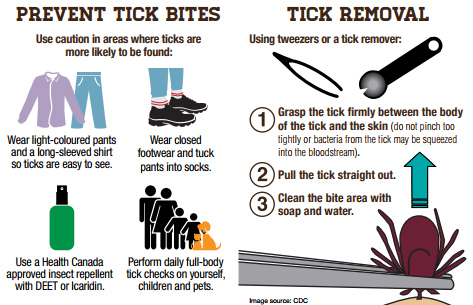Tick Bites: How to Protect Your Kids & What to Do if They Get One

I think we’ve all heard a lot about ticks being particularly bad, but do you know just how bad? I didn’t. In fact, before this article, I was kind of clueless about ticks, tick bites, Lyme disease, and how to keep both my kids and myself safe.
One thing I know for sure is that the thought of trying to keep my wild, nature-loving children out of forests and grassy areas during the warm weather is just a little bit fear-inducing.
So, we sought out an expert to help us make sense of it all. Because, apparently they are bad. In Ontario, more than half of us could be at risk of getting Lyme disease from tick bites because we live near or travel to at-risk areas.
Since I have zero desire to freak you out, I asked Dr. Doug Sider a few questions to calm my fears. As a retired public health physician and former medical director for Communicable Disease Prevention and Control at Public Health Ontario, Dr. Sider is more than qualified to clear up some of the mystery. Here’s what I learned.
Ticks: What They Are
Ticks are little insect-type animals that don’t fly, but climb up vegetation and sit and wait for hosts to brush by them, which allows them to latch on for a feeding.
Tick bites don’t generally hurt, and even if you are bitten by one, the likelihood of disease transmission is not a certainty. But it’s better to be safe than sorry.
How to Avoid Tick Bites
If you’re in a wooded area or in forested areas of parks, Dr. Sider suggests you try to avoid walking directly into the bush and avoid brushing up against high grasses or brush. Try to stay more in the center of the path to avoid coming into contact with ticks.
However, if that’s just not a reality, (if you live in a woodsy area, for example) here are some tips to avoid ticks and tick bites:
- Keep your grass mowed short
- Trim bushes and tree branches to let in sunlight (ticks avoid hot, dry locations)
- Create a border of gravel or woodchips one meter or wider around your yard if you’re next to a wooded, grassy area
- Remove leaf litter, brush, and weeds at the edge of the lawn and away from stone walls and woodpiles
- Move swing sets, playground equipment and sandboxes away from wooded areas and place on a woodchip or mulch foundation
How to Protect Your Kids From Tick Bites
The best thing you can do for your kids is have them wear light-coloured clothes with long pants and long sleeves, closed-toe shoes and socks (when possible) if they’re walking through brushy areas. This way, you’ll likely be able to see a tick and remove it before it bites.
Also, you may want to use a bug repellent containing DEET, since it’s effective at keeping ticks away. Obviously, you’ll want to make sure you read label directions, or ask your pharmacist or doctor for help when choosing a DEET product – but, in general, insect repellents with DEET are considered safe for kids over two years old when used in proper amounts. (And can be used in limited amounts for babies 6 months and up).
After being in a woody or forested area, check your kids’s scalp, ankles, behind their knees, and their armpits. Doing a “tick check” for them and for you is key after playing outside in high-risk areas.
If possible, try to take a shower or bath immediately after an outdoor activity to wash away any ticks that have not yet attached. You can also put clothes into a dryer on high heat for around an hour to kill any ticks that may be hanging on.
What to Do if You or Your Child Gets a Tick Bite
If the tick is attached, don’t try to “burn” it to pull it away from the skin. Burning a tick may actually inadvertently cause Lyme bacteria to be injected into the skin. If you’ve heard using nail polish or petroleum jelly helps pull it away from your skin, Dr. Sider says not to try those tricks either.
The safest and most effective way to remove an attached tick is to use your tweezers.
- Gently but firmly grasp the tick as close to your skin as possible
- Pull the tick straight out – don’t squeeze the tick as squeezing it can cause Lyme bacteria to be released into your body
- Thoroughly cleanse the bite site with rubbing alcohol and/or soap and water
After you’ve removed the tick, place it in a screw-top bottle and take it to your doctor or local health unit. They may send it out for testing to see if it has Lyme disease bacteria.
If you think you may be showing signs or symptoms of Lyme disease (things like fever, headache, fatigue, swollen glands, or an expanding non-itchy rash), see your doctor. Not everyone gets that tell-tale “bulls-eye” rash from a Lyme disease infection.
People with Lyme disease usually see symptoms after one or two weeks – but you can see them as early as three days or as long as a month after a tick bite. Basically, the earlier you get treated, the better. Early detection means Lyme disease can be treated successfully with two weeks of antibiotics.
Wellington-Dufferin-Guelph Public Health has this great handout for tick identification. Click here to take a look at the whole thing:
And you’ll find more information about Lyme here. Thanks to Dr. Sider for providing us with all this useful info!















